Menu
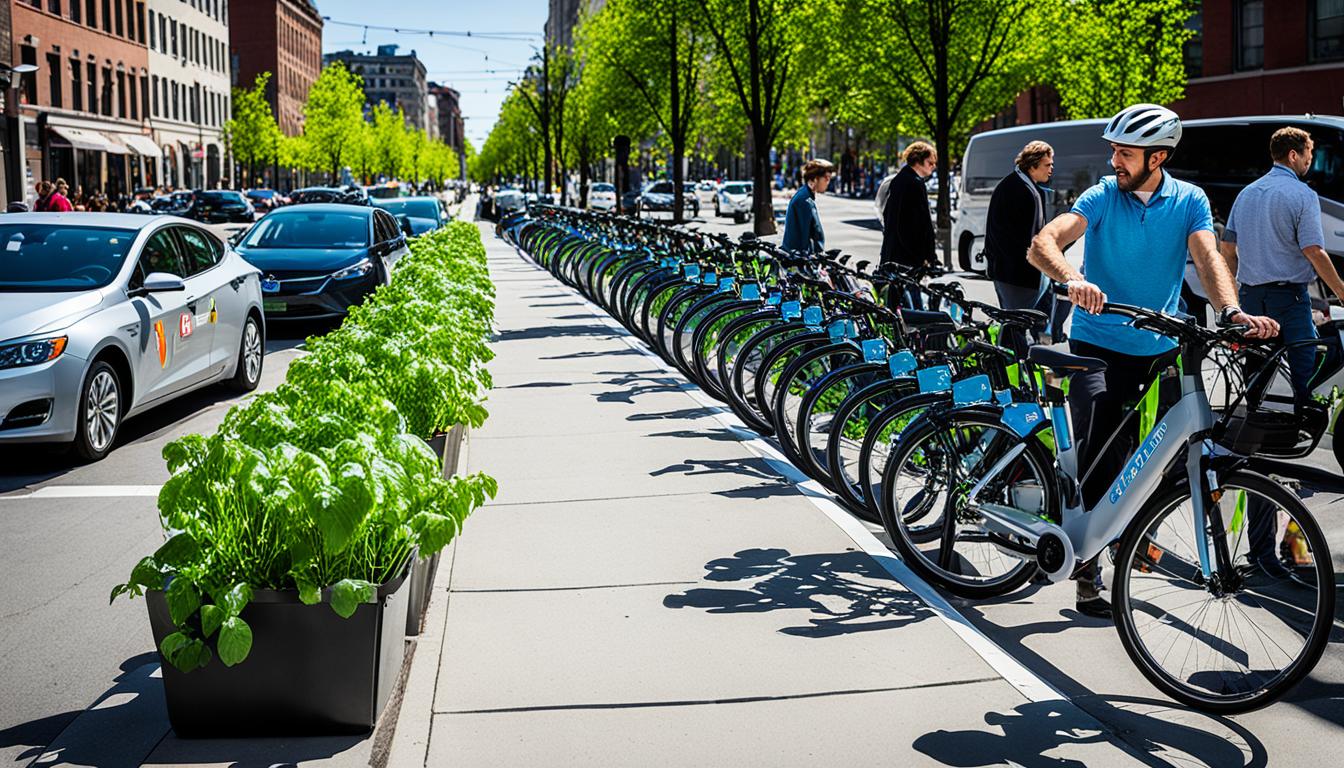
Did you know lowering your water heater to 120°F can help a lot? It cuts the carbon footprint from heating water. Also, using green power and choosing ENERGY STAR® appliances make a big difference. These steps show how living sustainably can benefit our planet.
The importance of being sustainable is growing. New green technologies aim to limit our impact on the earth. They include things like solar power and electric cars. Companies like Elemental Water Makers use the sun to make seawater fresh. This shows how we are moving towards a more eco-friendly future.
As we aim for a sustainable future, tackling environmental issues is key. The rise of green technology innovation is making a big difference. These new technologies help reduce the harm caused by people. They also offer new ways to live that are kinder to our planet.
Now, organisations are measuring their carbon footprints. This includes how much fuel and electricity they use, and their transport emissions. They show this impact in tCO2e. This helps companies understand their effect on the environment. It also guides them on where to improve.
In the UK, three-quarters of workplace electricity come from burning fossil fuels. This adds a lot to greenhouse gases. There are direct, electricity, and indirect emissions. Green technology is helping cut down on these harmful gases.
Key tech like solar desalination and green buildings are vital for our future. Solar desalination uses the sun to make water. It’s a green way to get a basic need. Green buildings use eco-friendly materials and save energy. They fight environmental issues caused by old building methods.
It’s not just big tech making a change. Even small steps count. For example, setting the water heater lower saves a lot of energy. Changing to LED or CFL lightbulbs and using less water in showers help a lot too. These simple changes cut down our energy use and reduce emissions.
To sum up, it takes all of us and new tech to solve today’s environmental challenges. Doing our part helps our planet and encourages new solutions. Together, we can move towards a better, greener future.
The move to green technologies is key for a sustainable future. These new ways reduce harm to the environment and promote climate-friendly projects. Using sources like solar and wind power helps us rely less on gas and coal.
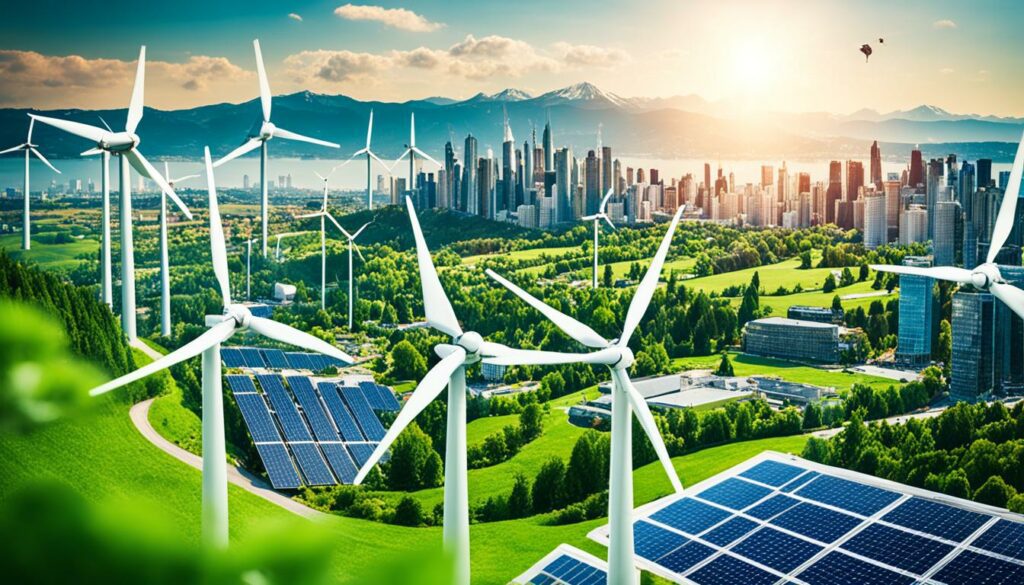
Solar power is now a cheaper option than fossil fuels. The International Energy Agency says solar energy beats coal and gas in cost in many places. Wind power is also set to grow, making up 71% of new energy by 2024.
Putting money into green tech helps the planet and the economy. If we double the number of green patents, our economy could grow by 1.7% in five years. Climate laws play a big part in this by encouraging more green tech patents and bringing in more green investments from abroad.
“The $1.2 Trillion Infrastructure Investment and Jobs Act signed by President Joe Biden in 2021 allocates substantial funds for green technology, including clean energy transmission and electric vehicle infrastructure.”
Green innovations do more than just help the planet. They also lead to more and better inventions. Countries working together on climate policies see more of these new green ideas. And, sharing tech across borders boosts everyone’s green innovations, creating a worldwide positive effect.
| Statistic | Impact |
|---|---|
| Doubling green patent filings | Boosts GDP by 1.7% after five years |
| Big increase in climate policies | Boosts green patent filings by 10% within five years |
| Solar and wind power | Expected to account for 71% of new energy capacity in 2024 |
| Kinds of renewable energy investments in 2022 | Surpassed $1.74 trillion globally |
Helping green tech grow is key for a cleaner, more sustainable world. By investing in eco-friendly projects, we pave the way for a brighter future.
Solar power is at the forefront of renewable energy. It plays a big part in lowering carbon dioxide levels and promoting global sustainability. Solar energy systems are used widely now, in homes and in businesses. They offer a real way to reduce our overall carbon footprint. It might surprise you that solar energy makes up only 8 TWh out of over 10,000 TWh of electricity worldwide. Yet, it has a huge effect on cutting emissions.
There are two key areas where solar power shines. One is in making sea water drinkable, called solar desalination. The other is in using the sun’s power to run things in our everyday lives. This includes both houses and places where businesses operate.
Using the sun to turn sea water into fresh water is a game-changer. Companies like Elemental Water Makers are leaders in this field. These projects take sea water and make it safe to drink, all powered by the sun. Besides the clean water they provide, they also lower our carbon footprint.
Putting solar panels on buildings is becoming more and more popular. In certain Southern European spots, these panels can pay for themselves in 1.5 to 2 years. In the middle of Europe, it’s about 2.7 to 3.5 years. These are good numbers for their cost. What’s more, solar panels cause much less pollution than gas or coal power.
Using solar power at home or at work means less CO2. Just having 1 MWh of solar power can cut 600 kilograms of CO2. Plus, more and more places are using solar power to heat their water. This has led to a drop of about 30 million tons of CO2 emissions every year.
| Factor | Solar Energy | Gas Power | Coal Power |
|---|---|---|---|
| Energy Payback | 1.5-3.5 years | – | – |
| CO2 Emissions (g/kWh) | 25-32 | 400 | 200 |
| Annual CO2 Savings (tons) | 30 million | – | – |
Ultimately, solar power cuts down on carbon dioxide. It does this by using the sun for things like making water clean and powering our homes. This clean energy source is key in reducing harmful gases. It also leads towards sustainable growth in many areas.
Wind power is a key player in renewable energy. It has the power to create clean electricity on a huge scale. In the United States, more than 125,000 people work in this sector, spread across all the states.
Wind farms are not only good for the planet but also boost the economy. They help cut down on harmful carbon emissions and drive forward new tech.
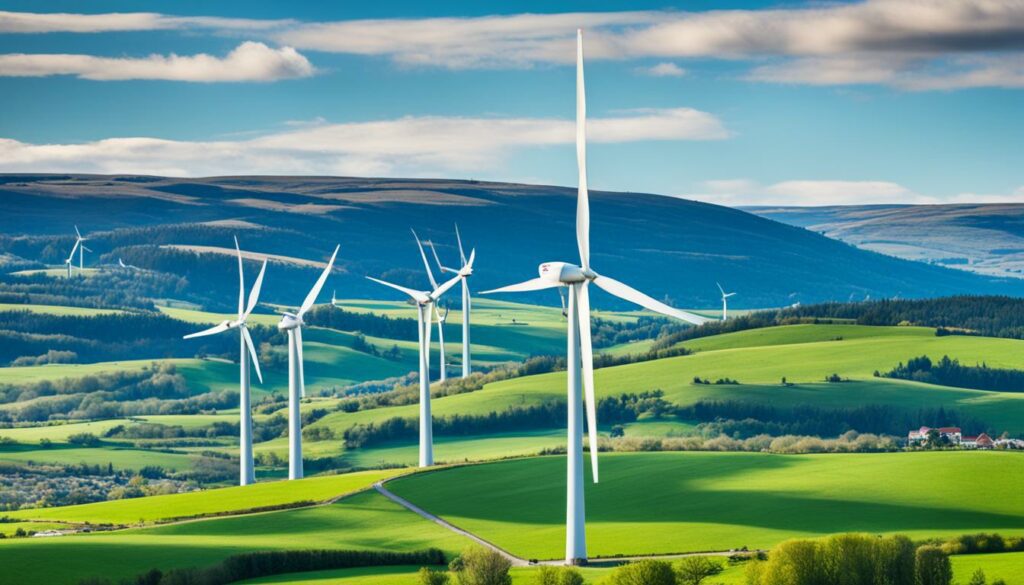
Wind turbine efficiency keeps getting better. In 2022, turbines helped make up over 10% of all energy produced in the U.S. This shows their growing importance.
Jobs in maintaining wind turbines are on the rise, highlighting the industry’s strength. Investment in new projects boosted the U.S. economy by $20 billion in 2022. This growth also increased tax revenues, helping both state and local areas.
Offshore wind farms are a big chance for the future of green energy. The market for this technology is growing fast. By 2030, it’s set to be worth over USD 98 billion.
Offshore wind is getting better thanks to new technologies. It now includes energy storage options, making it even more reliable. Plus, government support is helping it to become a key part of our energy mix.
| Statistics | Impact |
|---|---|
| Employees in the U.S. wind industry | 125,000+ |
| Wind turbine service technicians | Fastest-growing U.S. job of the decade |
| Energy production contribution in 2022 | More than 10% |
| Economic addition in 2022 | $20 billion |
| Carbon dioxide emissions avoided annually | 336 million metric tons |
Wind power plays a major role in creating a sustainable future. It’s proving to be cost-effective compared to traditional fuels. But, connecting these sources to cities with more people is vital for its success.
Electric vehicles (EVs) are changing the way we move, making travel cleaner and greener. They produce zero tailpipe emissions, a key step in fighting climate change. Governments worldwide are offering support for EVs through tax breaks and subsidies, helping us move towards a more sustainable future.
EVs play a major role in cutting down greenhouse gas emissions. By switching from petrol to electric cars, we reduce the harm done to our planet. Many countries are aiming to stop selling petrol cars, ensuring a cleaner world for us all.
Tesla stands out in this green revolution, leading the charge with their innovative EVs. Their work on batteries has helped lower prices, making EVs more affordable. There’s also a focus on finding sustainable ways to build EVs and the electrification of all kinds of transport, showing a promising future for green travel.
Green architecture is changing how buildings are made. It’s all about being both green and energy smart. This includes using the latest tech and energy sources to make buildings less harmful to the planet. It also aims to save a lot of energy, which is good for the environment and can save money too.
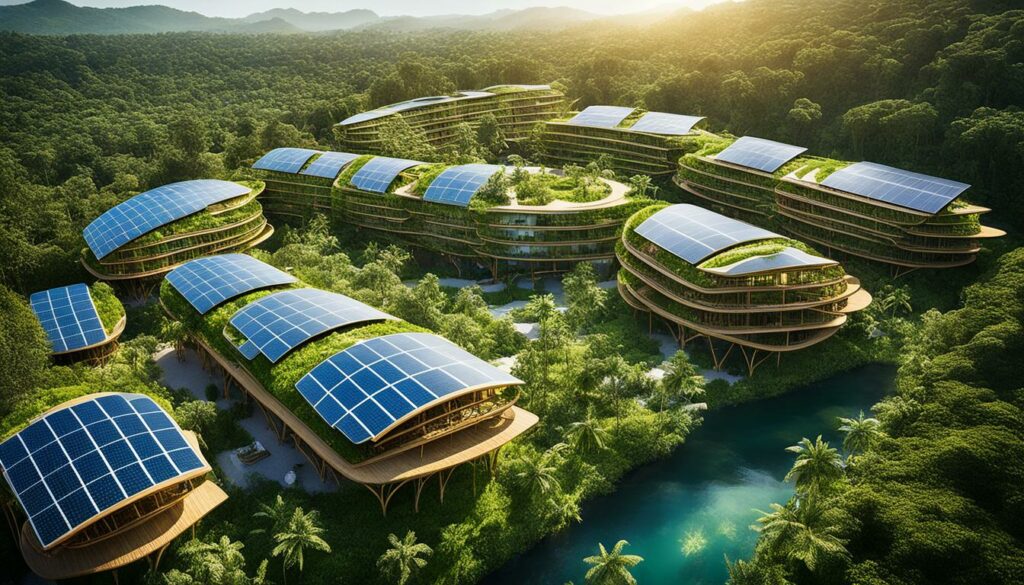
Buildings use a lot of electricity in the U.S. and create a huge amount of CO2. That’s why designing them to use less energy matters a lot. By using smart sensors and controls, buildings could use up to 29% less energy each year. But, this smart tech is more common in big buildings than in smaller ones. So, tools like LEED help architects make designs that are super good at saving energy.
Take Apple Park and the Googleplex as top examples. Apple Park is famous for using a lot of renewable energy and smart building methods. This makes it a model for energy-smart company bases. The design of the place, and its use of the sun for power, help cut down on how much carbon it makes.
The Googleplex is another leader in green building. Google wants its whole campus to create zero extra carbon. They use things like solar panels on their buildings and smart water systems. These choices help make the buildings more energy efficient and better for the planet. Apple and Google show how companies today are working hard to be kinder to Earth.
| Feature | Apple Park | Googleplex |
|---|---|---|
| Renewable Energy Usage | Yes | Yes |
| Energy-efficient Design | Optimised sensors and controls | Building-Integrated Photovoltaics |
| Water Management | Advanced systems | Optimised systems |
| Carbon Emissions Reduction | Passive design principles | Net-zero carbon goal |
These famous buildings show that green architecture can really work. By using new designs and tech, we can make better, greener buildings. This leads to a future where our cities and homes use less energy and do less harm to our planet.
Urbanisation is changing our world, making new agricultural ideas very important. Controlled-environment agriculture is one such idea, focusing on vertical farming and hydroponics. These methods help us grow food in a modern, more eco-friendly way.
By 2032, the market for vertical farming could reach $40.45 billion. It’s growing fast at a rate of 26.4% each year. In 2023, North America led with sales hitting $1.96 billion.
This kind of farming uses space better and saves a lot of water. For example, hydroponics indoors can reduce water use by almost 100%. It shows that growing food locally in this way can produce more and better crops than traditional farming.
| Crop | Growth Duration (Days) |
|---|---|
| Lettuce | 30 |
| Herbs | 25 |
| Tomatoes | 45 |
| Peppers | 35 |
| Strawberries | 40 |
Vertical farming is great for saving space and reducing carbon emissions. It does this by not needing a lot of transport for the food. Places like Plant Chicago and Sky Greens show we can grow fresh food all year, even in tough climates.
New tech like LED lights, smart control, and using data wisely are changing how we farm vertically. It makes local, all-year food production more stable. This way, we cut greenhouse gases from farming a lot.
Carbon Capture and Storage (CCS) is crucial for cutting CO2 emissions and fighting the greenhouse effect. It’s used by big names like ExxonMobil and Shell to reduce harm from industrial carbon. transport, supporting the fight against climate change.
CCS captures carbon dioxide from factories and stores it underground. By doing this, it limits the CO2 that goes into the air and helps with climate change. ExxonMobil manages more than 1,500 miles of CO2 pipelines in the U.S. and can now store CO2 in multiple places, thanks to buying Denbury Inc.
This expansion could reduce over 100 million tons of CO2 each year, showing how big an impact CCS can have.

ExxonMobil and Shell are putting a lot into CCS to cut the greenhouse effect. ExxonMobil is enhancing its setup with extra pipelines and storage places. They’re also working to make the financial side better for these projects, which will help a lot.
Shell and others are finding new ways to store and use the captured CO2 for a better tomorrow.
The U.S. runs 15 CCS sites that can take in 0.4% of the country’s yearly CO2. But, they’re working on 121 more facilities that could reach up to 3% soon. The U.S. Department of Energy and plans to improve TIFIA show a big push for using CCS more, promising a major drop in CO2 soon.
Plant-based packaging, led by Avantium, provides green packaging options. It is made from things like corn, sugarcane, and potatoes. This makes them good for the earth because they can break down and are always being renewed. They help lower the bad effects of normal plastic.
Plant-based packages help lessen plastic waste. They use less energy and make less greenhouse gas than regular plastic ones. This means they have a smaller impact on the planet. They are popular with people and companies that care about the environment.
Businesses choosing plant-based packaging stand out. They meet the desire for greener goods from shoppers. Since these packages can disappear over time, they help cut down on plastic waste. This is a big step towards fixing our planet.
Companies like Avantium are key. They work hard to create plant-based packages that are kind to the earth. By doing this, they help the planet and also make money. This is because more people are wanting these kinds of products.
Companies like Fairphone and Teracube lead in making eco-friendly phones. They create devices that are tough and easy to fix. This helps lower electronic waste and makes their products more sustainable.
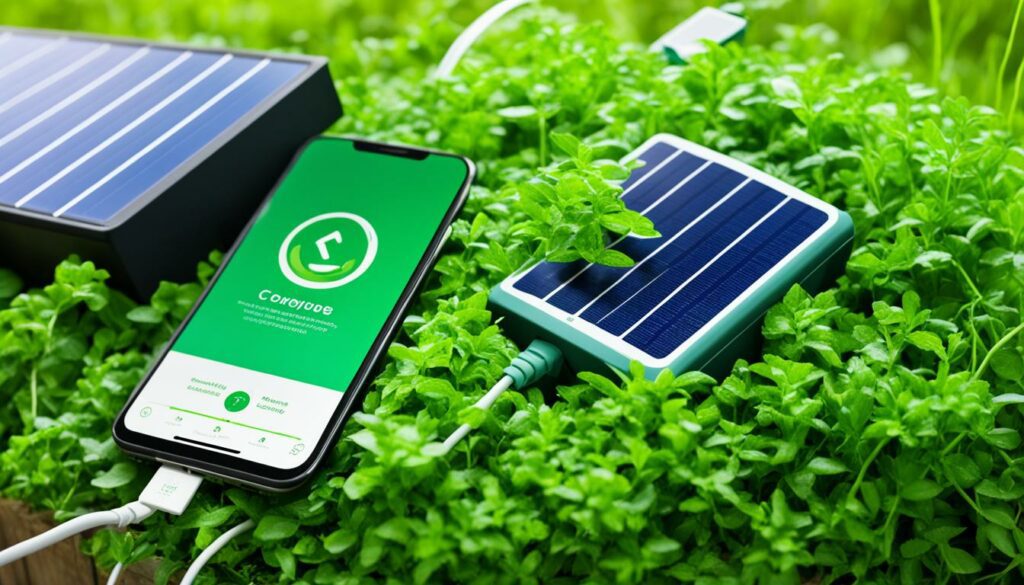
Fairphone and Teracube focus on making electronics last a long time. Fairphone has increased the phones recycled by 18% each year, hitting 23% in 2020. They also aim to use 70% ethically sourced materials in five years, supporting green tech.
Teracube offers phones that can be repaired easily and come with a four-year warranty. Durable devices last longer, reducing waste and offering green choices to buyers.
Fairphone sourced 45% of essential materials sustainably in 2020, up from 25.37% during Fairphone 2’s launch. They also boost factory worker’s pay to 1.5 times the local norm, showing their social concern.
Fairphone wants 9,000 people to benefit from their actions by 2020, which is a big goal. They work hard to use more eco-friendly materials and improve recycling efforts.
Companies like Fairphone and Teracube prove that tech innovation can go hand-in-hand with saving the planet. They’re key players in moving the tech world towards a greener, better future.
The world is making more electronic devices than ever. This means there’s a lot of electronic waste (e-waste). To tackle this problem, we need better ways to recycle these devices.
New technologies like robots and artificial intelligence are making a big difference in recycling e-waste. These new ways are not just faster but also safer. They help in separating out dangerous materials from old devices.
When it comes to pulling out metals from the devices, a new method called hydrometallurgical processes is a step forward. It is better for the environment than the old smelting ways. Also, using tiny living things to get metals out of e-waste is turning out well.
Good management of e-waste helps save resources and keeps our planet cleaner. Some laws make sure companies deal with their products responsibly from start to finish. This encourages them to come up with better ways to recycle and dispose of old devices.
Making gadgets in a way that parts can be replaced helps them last longer. This helps cut down on how much electronic waste we make. The idea of mining metals from old devices in cities is also catching on. It’s a greener way to get valuable materials back.
Teaching people about how to handle electronic waste and working together across the world are also key. These efforts make a big picture in fighting the growing e-waste problem.
To beat the e-waste crisis, we need laws, efforts from companies, and the latest recycling tech. These are our best bets for saving resources and caring for our environment.
The move to renewable energy is key in our fight against climate change. It changes our energy sources from fossil fuels to things like solar and wind. Doing this helps lower carbon emissions and makes our planet better for those who come after us.
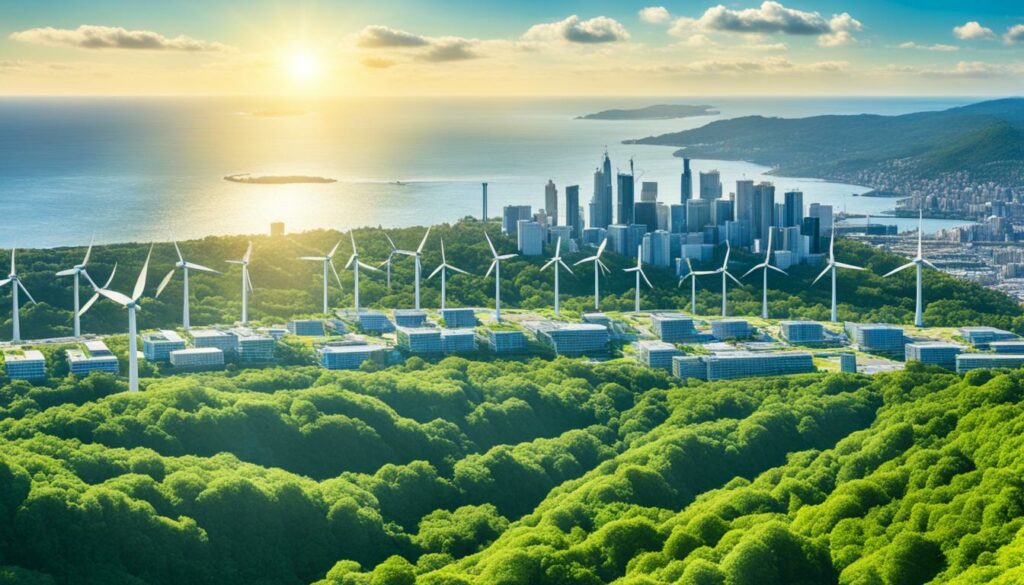
Using renewable energy helps reduce carbon footprints everywhere. A study in 2020 showed that renewable energy in China cuts down on pollution. Also, research in 2021 found that as the world becomes more connected, it uses its money and energy smarter. This leads to less pollution.
Moving to renewable energy cuts greenhouse gases and helps the economy grow in a healthy, lasting way. For example, meeting the goals of the Paris Agreement heavily depends on using more renewable energy. This agreement wants to keep the earth from warming more than 2.0°C by 2050.
Many examples show how switching to renewable energy is a win for the environment:
| Country | Initiative | Outcome |
|---|---|---|
| United Kingdom | Commitment to carbon neutrality by 2050 | Significant reduction in carbon emissions |
| China | Massive investment in solar and wind energy | Decreased degradation and emissions |
| Ghana | Focus on reducing fossil fuel consumption | Better environmental sustainability |
| Africa | Integration of renewable energy with economic growth | Enhanced environmental quality |
Shifting to renewable energy is a must and it’s also smart. It offers a clean and promising future. By investing in this change, we get cleaner air, economic growth, and many other good things. These steps are crucial for reaching zero net emissions by the middle of this century.
Homeowners can do a lot to lower their carbon footprint by focusing on home energy efficiency. Improving insulation and sealing can cut energy use by 10%. This is big since most of our home energy is for heating and cooling.
Passive House Design homes use up to 90% less energy for these. This shows the power of good insulation.
Installing green home improvements helps the planet a lot. Energy-saving appliances and smart tech are key. Smart thermostats can reduce costs by 10%. LED lights save up to 75% energy and last longer.
Energy Recovery Ventilation (ERV) cuts costs by 40%. This makes a home more energy efficient.
Advanced systems like heat pumps are also great for nature. They work well. For example, ground source heat pumps are three times more efficient than oil. Air-source heat pumps use 65% less electricity for heating and cooling.
Heat pumps are now more popular than gas furnaces thanks to their benefits. Plus, heat pump water heaters can save homeowners up to $550 a year. This is with IRA tax credits that cover much of the cost.
Green roofs and Insulated Concrete Forms (ICFs) also help a lot. Green roofs offer natural insulation, reducing energy use by 25%. ICFs can cut costs in half. They show how important good building techniques are for the environment.
President Biden aims for a 100% clean energy economy by 2050. Embracing these changes will help us reach that goal. Plus, it lowers our ecological footprint, moving us towards a sustainable future.
Using renewable energies like solar and wind power is a great start. You can also make your home more energy efficient. And, if possible, switch to electric vehicles for cleaner transport.
Green tech cuts CO2 emissions and pushes us towards renewables. It tackles issues like too little water and too much plastic with smart, green answers.
Solar power turns sunlight into electricity, perfect for homes and businesses. It even helps with big problems like not enough water with methods like solar desalination.
New wind turbines are better at catching the wind and making power. This improvement means wind power is becoming a key part of our clean energy mix.
Electric cars don’t release any emissions from the exhaust pipe. They use advanced batteries which we hope will lower carbon levels and reduce our oil use.
Apple Park and the Googleplex are good examples. They use designs and systems to save energy and use renewables, helping the planet and setting a good example for others.
These farming methods need less space and transport. They can grow food right where people live, reducing the need for long journeys. This helps the environment and supports eco-farming.
CCS catches CO2 from making things and hides it underground. Or, it finds ways to use this CO2 in safe, helpful ways. This stops some CO2 from reaching the air, which is good for the planet.
Plant-based packaging breaks down easily and doesn’t make as many greenhouse gases as plastic. This lessens the harm of getting rid of it, compared to plastic made from oil.
A sustainable phone lasts a long time and can be fixed. It’s made in a way that hurts the planet less. Fairphone and Teracube make phones like this, reducing waste and being kind to the earth.
Recycling old tech saves valuable materials. It also stops e-waste from harming nature, with modern, clean ways to recycle that protect our environment.
Moving towards solar and wind power cuts down on carbon and oil use. This change makes our energy cleaner and safer for the world we live in.
Adding better insulation, windows, and efficient appliances to your home can save a lot of energy. This helps cut carbon and leads to a greener way of living.